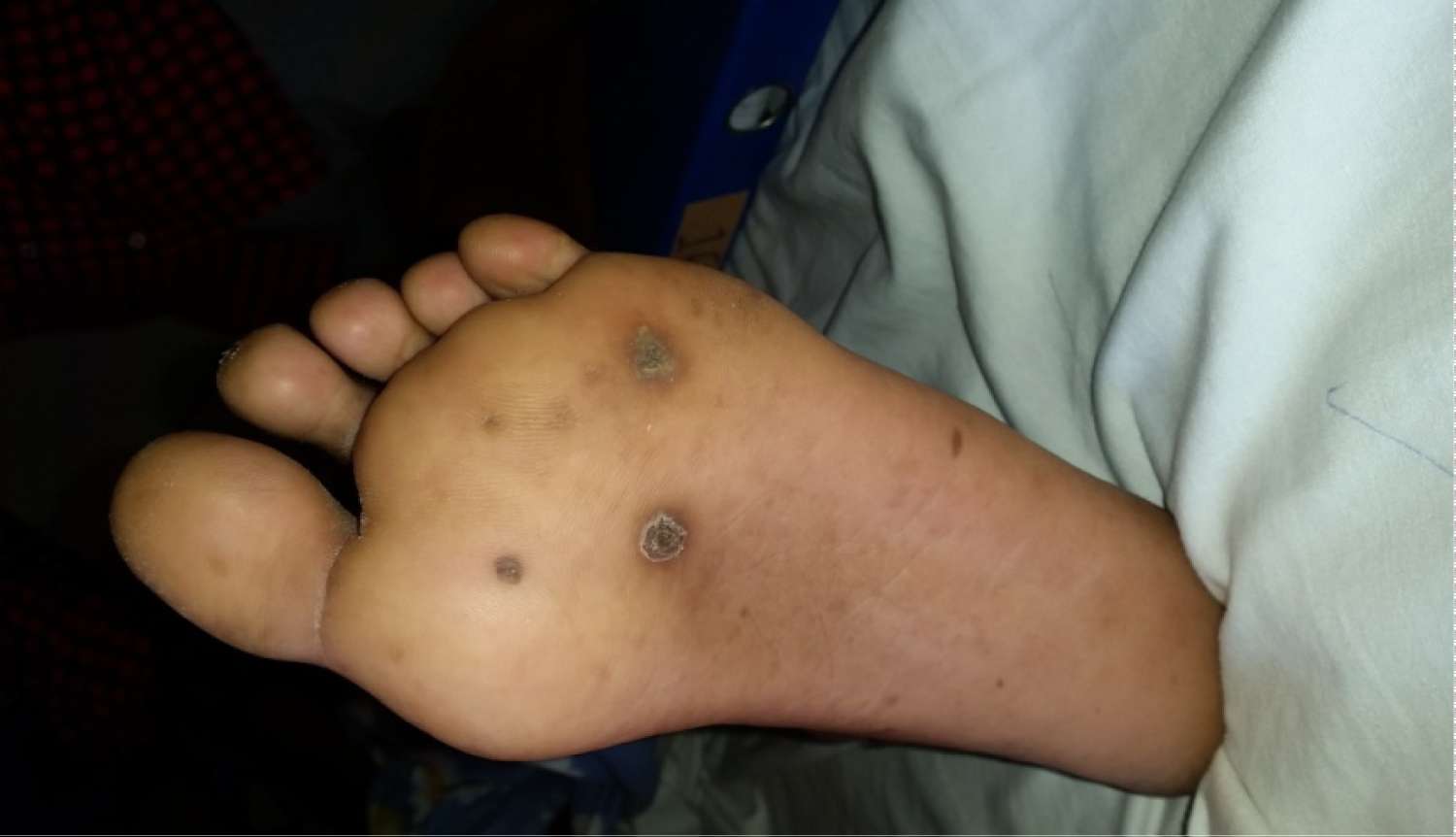Tetanus

What is Tetanus?
Clostridium tetani, the bacteria that causes Tetanus, are commonly found in soil, saliva, dust, and manure. Once infected, the person may experience painful muscular contractions, especially in the jaw and neck region. It is also called Lockjaw as the patient may find it difficult to breathe, swallow, and move their mouth and neck.
How is Tetanus Transmitted?
Spores of the Tetanus bacteria are commonly present in the environment around us. A person risks being primarily infected if the bacteria enters the body, usually through injuries caused by contaminated objects. As per the CDC, Clostridium tetani may cause an infection through the following: Wounds contaminated with dirt faeces or ,saliva ,Puncture wounds, with nail or needle, Burns, Crush injuries
Injuries with dead tissue
According to the CDC, some of the other ways that the Tetanus bacteria can infect you include:
Clean superficial wounds
Surgical procedures
Insect bites
Dental infections
Compound fractures (exposed bone)
Chronic sores and infections
Intravenous (IV) drug use
Intramuscular injections
While the incubation period (time from exposure to illness) is 3 to 21 days, most cases are seen between 10 to 14 days. Shorter incubation periods are seen in cases like:
More heavily contaminated wounds
More serious disease
Tetanus cannot be transmitted from person to person.
Symptoms and Complications of Tetanus
Tetanus infections are usually seen in individuals who have never been vaccinated against it. According to the WHO, some of the common symptoms include:
Cramped jaw or difficulty in opening mouth, difficulties in swallowing and breathing, muscle spasms, usually in the back, abdomen, and extremities, seizures, headache
fever and sweating, blood pressure or heart rate changes
The bacteria may affect newborns as well. Common signs of neonatal symptoms include muscle spasms and difficulties in being breastfed or sucking, often accompanied by crying.
When Should a Child Receive Vaccination for Tetanus?
Tetanus vaccination can offer protection against Tetanus . According to the Indian Academy of Pediatrics (IAP) Advisory Committee on Vaccines and Immunization Practices (ACVIP), the vaccine is administered in three doses, each dose at the following ages:
6 weeks of age
10 weeks of age
14 weeks of age
Furthermore, booster doses for tetanus vaccination are to be given at the ages of 16-18 months and 4-6 years.
Tdap (reduced antigen combined tetanus, diphtheria and acellular pertussis) at 10-12 years.
Booster doses (Tdap) are required for adults as well.
Please consult your paediatrician for more information.
What are the Common Side Effects Associated with Tetanus Vaccination?
As with several vaccinations, tetanus vaccinations may also cause soreness, redness, or swelling at the site of the injection. Some other severe but rare side effects include, seizures, coma, permanent brain damage and altered consciousness.
For more details on side effects, please consult your doctor.
टेटनस क्या है?
क्लोस्ट्रीडियम टेटानी, बैक्टीरिया जो टेटनस का कारण बनता है, आमतौर पर मिट्टी, लार, धूल और खाद में पाया जाता है। एक बार संक्रमित होने के बाद, व्यक्ति को दर्दनाक मांसपेशियों के संकुचन का अनुभव हो सकता है, विशेष रूप से जबड़े और गर्दन के क्षेत्र में। इसे लॉकजॉ भी कहा जाता है क्योंकि रोगी को सांस लेने, निगलने और अपने मुंह और गर्दन को हिलाने में मुश्किल हो सकती है।
टेटनस कैसे फैलता है?
टेटनस बैक्टीरिया के बीजाणु आमतौर पर हमारे आसपास के वातावरण में मौजूद होते हैं। एक व्यक्ति को मुख्य रूप से संक्रमित होने का जोखिम होता है यदि बैक्टीरिया शरीर में प्रवेश करता है, आमतौर पर दूषित वस्तुओं के कारण होने वाली चोटों के माध्यम से। सीडीसी के अनुसार,
क्लोस्ट्रीडियम टेटानी निम्नलिखित के माध्यम से संक्रमण का कारण बन सकता है:गंदगी, मल, या लार से दूषित घावपंचर घाव, कील या सुई सेबर्न्सक्रश इंजरीमृत ऊतक के साथ चोटेंसीडीसी के अनुसार, कुछ अन्य तरीके जिनसे टेटनस बैक्टीरिया आपको संक्रमित कर सकते हैं, उनमें शामिल हैं:साफ सतही घावशल्य प्रक्रियाएंदंशदांतों में संक्रमणयौगिक फ्रैक्चर (उजागर हड्डी)जीर्ण घाव और संक्रमणअंतःशिरा (चतुर्थ) नशीली दवाओं का उपयोगइंट्रामस्क्युलर इंजेक्शनजबकि ऊष्मायन अवधि (बीमारी के संपर्क में आने का समय) 3 से 21 दिनों का होता है, ज्यादातर मामले 10 से 14 दिनों के बीच देखे जाते हैं।
कम ऊष्मायन अवधि ऐसे मामलों में देखी जाती है जैसे:अधिक भारी दूषित घावअधिक गंभीर रोगटिटनेस एक व्यक्ति से दूसरे व्यक्ति में संचरित नहीं किया जा सकता है।
टिटनेस के लक्षण और जटिलताएंटेटनस संक्रमण आमतौर पर उन व्यक्तियों में देखा जाता है जिन्हें इसके खिलाफ कभी टीका नहीं लगाया गया है। डब्ल्यूएचओ के अनुसार, कुछ सामान्य लक्षणों में शामिल हैं:तंग जबड़ा या मुंह खोलने में कठिनाईनिगलने और सांस लेने में कठिनाईमांसपेशियों में ऐंठन, आमतौर पर पीठ, पेट और हाथ-पांव में बरामदगी सर दर्द बुखार और पसीना रक्त चाप या हृदय गति में परिवर्तन बैक्टीरिया नवजात शिशुओं को भी प्रभावित कर सकता है। नवजात लक्षणों के सामान्य लक्षणों में मांसपेशियों में ऐंठन और स्तनपान या चूसने में कठिनाई शामिल है, अक्सर रोने के साथ।
बच्चे को टिटनेस का टीका कब लगवाना चाहिए?
टेटनस टीकाकरण टेटनस के खिलाफ सुरक्षा प्रदान कर सकता है। इंडियन एकेडमी ऑफ पीडियाट्रिक्स (आईएपी) के टीके और टीकाकरण प्रथाओं पर सलाहकार समिति (एसीवीआईपी) के अनुसार, टीके को तीन खुराक में प्रशासित किया जाता है,
प्रत्येक खुराक निम्नलिखित उम्र में:6 सप्ताह की आयु10 सप्ताह की आयु14 सप्ताह की आयुइसके अलावा, टेटनस टीकाकरण के लिए बूस्टर खुराक 16-18 महीने और 4-6 साल की उम्र में दी जानी है।टीडीएपी (कम प्रतिजन संयुक्त टेटनस, डिप्थीरिया और अकोशिकीय पर्टुसिस) 10-12 वर्षों में।वयस्कों के लिए भी बूस्टर खुराक (टीडीएपी) की आवश्यकता होती है।
अधिक जानकारी के लिए कृपया अपने बाल रोग विशेषज्ञ से सलाह लें।हालांकि, अधिक जानकारी के लिए अपने डॉक्टर से सलाह लें।
टेटनस टीकाकरण से जुड़े सामान्य दुष्प्रभाव क्या हैं?
कई टीकों की तरह, टिटनेस के टीके भी इंजेक्शन के स्थान पर दर्द, लालिमा या सूजन का कारण बन सकते हैं। कुछ अन्य गंभीर लेकिन दुर्लभ दुष्प्रभावों में शामिल हैं, दौरे, कोमा, स्थायी मस्तिष्क क्षति और परिवर्तित चेतना।यदि आप ऐसे किसी भी लक्षण को देखते हैं, तो तुरंत अपने बाल रोग विशेषज्ञ से परामर्श लें।साइड इफेक्ट के बारे में अधिक जानकारी के लिए, कृपया अपने चिकित्सक से परामर्श करें।
ટિટાનસ શું છે?
ક્લોસ્ટ્રિડિયમ ટેટાની, બેક્ટેરિયા જે ટિટાનસનું કારણ બને છે, તે સામાન્ય રીતે માટી, લાળ, ધૂળ અને ખાતરમાં જોવા મળે છે. એકવાર ચેપ લાગ્યો, વ્યક્તિ પીડાદાયક સ્નાયુબદ્ધ સંકોચન અનુભવી શકે છે, ખાસ કરીને જડબા અને ગરદનના પ્રદેશમાં. તેને લોકજૉ પણ કહેવામાં આવે છે કારણ કે દર્દીને શ્વાસ લેવામાં, ગળવામાં અને મોં અને ગરદનને ખસેડવામાં મુશ્કેલી પડી શકે છે.
ટિટાનસ કેવી રીતે પ્રસારિત થાય છે?
ટિટાનસ બેક્ટેરિયાના બીજકણ સામાન્ય રીતે આપણી આસપાસના વાતાવરણમાં હાજર હોય છે. જો બેક્ટેરિયા શરીરમાં પ્રવેશે છે, તો સામાન્ય રીતે દૂષિત વસ્તુઓને કારણે થતી ઇજાઓ દ્વારા વ્યક્તિને પ્રાથમિક રીતે ચેપ લાગવાનું જોખમ રહે છે. CDC મુજબ, ક્લોસ્ટ્રિડિયમ ટેટાની નીચેના દ્વારા ચેપનું કારણ બની શકે છે:ગંદકી, મળ અથવા લાળથી દૂષિત ઘાનખ અથવા સોય સાથે, પંચર ઘાબળે છેકચડી ઇજાઓમૃત પેશી સાથે ઇજાઓસીડીસી અનુસાર, ટિટાનસ બેક્ટેરિયા તમને સંક્રમિત કરી શકે તેવી અન્ય કેટલીક રીતોમાં શામેલ છે:સપાટીના ઘા સાફ કરોસર્જિકલ પ્રક્રિયાઓજીવજંતુ કરડવાથીડેન્ટલ ચેપસંયોજન અસ્થિભંગ (ખુલ્લા હાડકા)ક્રોનિક ચાંદા અને ચેપનસમાં (IV) ડ્રગનો ઉપયોગઇન્ટ્રામસ્ક્યુલર ઇન્જેક્શનજ્યારે સેવનનો સમયગાળો (બીમારીના સંપર્કમાં આવવાનો સમય) 3 થી 21 દિવસનો હોય છે, મોટા ભાગના કેસ 10 થી 14 દિવસની વચ્ચે જોવા મળે છે. ટૂંકા સેવનનો સમયગાળો આવા કિસ્સાઓમાં જોવા મળે છે:વધુ ભારે દૂષિત ઘાવધુ ગંભીર રોગટિટાનસ વ્યક્તિથી વ્યક્તિમાં સંક્રમિત થઈ શકતું નથી.ટિટાનસના લક્ષણો અને ગૂંચવણોટિટાનસ ચેપ સામાન્ય રીતે એવા વ્યક્તિઓમાં જોવા મળે છે જેમને તેની સામે ક્યારેય રસી આપવામાં આવી નથી. ડબ્લ્યુએચઓ અનુસાર, કેટલાક સામાન્ય લક્ષણોમાં નીચેનાનો સમાવેશ થાય છે:જડબામાં ખેંચાણ અથવા મોં ખોલવામાં મુશ્કેલીગળી જવા અને શ્વાસ લેવામાં તકલીફસ્નાયુઓમાં ખેંચાણ, સામાન્ય રીતે પાછળ, પેટ અને હાથપગમાંહુમલામાથાનો દુખાવોતાવ અને પરસેવોબ્લડ પ્રેશર અથવા હૃદય દરમાં ફેરફારબેક્ટેરિયા નવજાત શિશુને પણ અસર કરી શકે છે. નવજાત લક્ષણોના સામાન્ય ચિહ્નોમાં સ્નાયુઓમાં ખેંચાણ અને સ્તનપાન અથવા ચૂસવામાં મુશ્કેલીઓનો સમાવેશ થાય છે, ઘણી વખત રડવું સાથે.બાળકને ટિટાનસ માટે ક્યારે રસી આપવી જોઈએ?ટિટાનસ રસીકરણ ટિટાનસ સામે રક્ષણ આપી શકે છે. ઈન્ડિયન એકેડેમી ઓફ પેડિયાટ્રિક્સ (IAP) એડવાઈઝરી કમિટી ઓન વેક્સિન્સ એન્ડ ઈમ્યુનાઈઝેશન પ્રેક્ટિસ (ACVIP) અનુસાર, આ રસી ત્રણ ડોઝમાં આપવામાં આવે છે, દરેક ડોઝ નીચેની ઉંમરે આપવામાં આવે છે:6 અઠવાડિયાની ઉંમર10 અઠવાડિયાની ઉંમર14 અઠવાડિયાની ઉંમરવધુમાં, ટિટાનસ રસીકરણ માટે બૂસ્ટર ડોઝ 16-18 મહિના અને 4-6 વર્ષની ઉંમરે આપવાના છે.Tdap (ઘટાડો એન્ટિજેન સંયુક્ત ટિટાનસ, ડિપ્થેરિયા અને એસેલ્યુલર પેર્ટ્યુસિસ) 10-12 વર્ષમાં.પુખ્ત વયના લોકો માટે પણ બુસ્ટર ડોઝ (Tdap) જરૂરી છે.વધુ માહિતી માટે કૃપા કરીને તમારા બાળરોગ ચિકિત્સકની સલાહ લો.જો કે, વધુ માહિતી માટે તમારા ડૉક્ટરની સલાહ લો.
ટિટાનસ રસીકરણ સાથે સંકળાયેલી સામાન્ય આડ અસરો શું છે?
વિવિધ રસીકરણોની જેમ, ટિટાનસ રસીકરણ પણ ઈન્જેક્શનના સ્થળે દુખાવો, લાલાશ અથવા સોજોનું કારણ બની શકે છે. કેટલીક અન્ય ગંભીર પરંતુ દુર્લભ આડઅસરોમાં હુમલા, કોમા, મગજને કાયમી નુકસાન અને બદલાયેલ ચેતનાનો સમાવેશ થાય છે.જો તમને આવા કોઈ લક્ષણો દેખાય, તો તરત જ તમારા બાળરોગ ચિકિત્સકની સલાહ લો.આડઅસરો વિશે વધુ વિગતો માટે, કૃપા કરીને તમારા ડૉક્ટરની સલાહ લો.
